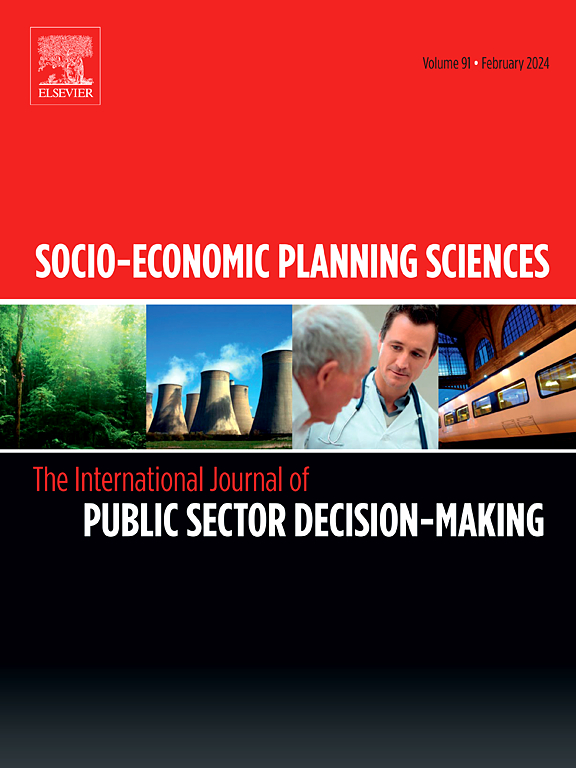基于复杂网络的中国机场非法干扰应急处置脆弱性评估与决策分析——以区域机场为例
IF 5.4
2区 经济学
Q1 ECONOMICS
引用次数: 0
摘要
由于机场容易受到非法干扰,因此有必要进行基于模型的脆弱性分析,以量化机场安全系统的鲁棒性和故障恢复能力。为此,本文建立了攻防博弈与复杂网络相结合的融合模型,对机场应急处置网络进行系统分析。首先,构建了基于非法干扰事件应急处置过程的攻防博弈模型。引入成本效益分析,拓宽博弈模型。然后,基于攻防关系构建了机场非法干扰应急处置复杂网络。本研究提出的方法适用于区域性机场。以张家界和花国际机场为例进行了仿真分析。通过对网络拓扑结构和脆弱性的深入分析,本研究发现机场非法干扰应急处置网络具有小世界网络特征,保证了应急处置过程中信息的高效传播和资源的高效分配。机场安全在防御网络中起着关键的中介作用,公安策略集构成了一个紧密的子网络。这些特点增强了网络的整体应急处置能力。脆弱性评估结果表明,网络虽然能够抵御随机攻击,但极易受到蓄意攻击。因此,有必要增强应急处置网络的弹性。根据脆弱性评估结果对网络进行优化。结果表明,网络的弹性提高了10.98%。它将有助于机场保安更有效地应对非法干扰事件,从而有助于更广泛地了解复杂社会经济系统中风险和不确定性下的决策。本文章由计算机程序翻译,如有差异,请以英文原文为准。
Vulnerability assessment and decision analysis of airport unlawful interference emergency disposal based on complex network in China: Take regional airports for example
Since airports are vulnerable to unlawful interference, it is necessary to conduct a model-based vulnerability analysis to quantify the robustness and failure resilience of airport security systems. Therefore, this work establishes a fusion model that combines attack-defense games with complex networks to systematically analyze the airport emergency disposal network. Firstly, an attack-defense game model is constructed based on emergency disposal process of unlawful interference incidents. Introducing cost-benefit analysis to broaden the game model. Then the complex network of airport unlawful interference emergency disposal is constructed based on the attack-defense relationship. The method proposed in this study is applicable to regional airports. A simulation analysis is conducted using Zhangjiajie Hehua International Airport in China as an example. Through in-depth analyses of the network topology and vulnerability, this study finds that the airport unlawful interference emergency disposal network has small-world network characteristics, which ensures efficient information dissemination and resource allocation during emergency disposal. Airport security plays a key intermediary role in the defense network, and the strategy sets of public police form a tight sub-network. These characteristics enhance the overall emergency disposal capability of the network. The results of the vulnerability assessment show that although the network is able to withstand random attacks, it is highly vulnerable to deliberate attacks. Therefore, it is necessary to enhance the resilience of the emergency disposal network. Optimize the network based on the results of the vulnerability assessment. The results showed that the resilience of the network increased by 10.98 %. It will help airport security to respond more effectively to incidents of unlawful interference, thus contributing to the broader understanding of decision-making under risk and uncertainty in complex socio-economic systems.
求助全文
通过发布文献求助,成功后即可免费获取论文全文。
去求助
来源期刊

Socio-economic Planning Sciences
OPERATIONS RESEARCH & MANAGEMENT SCIENCE-
CiteScore
9.40
自引率
13.10%
发文量
294
审稿时长
58 days
期刊介绍:
Studies directed toward the more effective utilization of existing resources, e.g. mathematical programming models of health care delivery systems with relevance to more effective program design; systems analysis of fire outbreaks and its relevance to the location of fire stations; statistical analysis of the efficiency of a developing country economy or industry.
Studies relating to the interaction of various segments of society and technology, e.g. the effects of government health policies on the utilization and design of hospital facilities; the relationship between housing density and the demands on public transportation or other service facilities: patterns and implications of urban development and air or water pollution.
Studies devoted to the anticipations of and response to future needs for social, health and other human services, e.g. the relationship between industrial growth and the development of educational resources in affected areas; investigation of future demands for material and child health resources in a developing country; design of effective recycling in an urban setting.
 求助内容:
求助内容: 应助结果提醒方式:
应助结果提醒方式:


